308
PART I: COLUMNS IN CLASSICAL ARCHITECTURE by xv12commander
This guide is still incomplete and under development and it will be continuosly updated to answer your doubts and questions!The first section is meant to give a brief historical background about classical architecture, but you can skip it and go directly to the Minecraft guide below! (Section 4)
1) INTRODUCTION
Columns can be seen anywhere in classical architecture, and it would be hard to find any building designed in a classical style which doesn't feature them!Classical architecture is clearly effective in giving a beautiful and mighty look to any building, and columns are probably very much involved in it. Observing these buildings from very different times and places you can see the effect that columns have on their facades:


"Beauty" is partially an individual matter of course, so you may like them or not, but you can't disagree on the fact that these facades clearly say something about the importance of these buildings, even though they are very different from each other.
However columns are part of architecture from much more time than the previous buildings are standing, in fact each of those designs might be considered a re-elaborated version of older models coming from ancient times...

2) ORIGINS
Columns as we can see them today originated in ancient Greece around 700-800 BC. At that time, massive Doric columns where popular as distinctive feature of many Greek temples, though they were still a bit unrefined and "rustic". The design of the columns is ispired by nature, they reminds indeed some tree trunks and they share the same function: to steadily sustain the impressive weight of the superstructure in the strongest but most elegant way possible. We can say that columns are as beautiful as useful, an important and crucial characteristic of ancient architecture which tend to be completely lost nowadays...

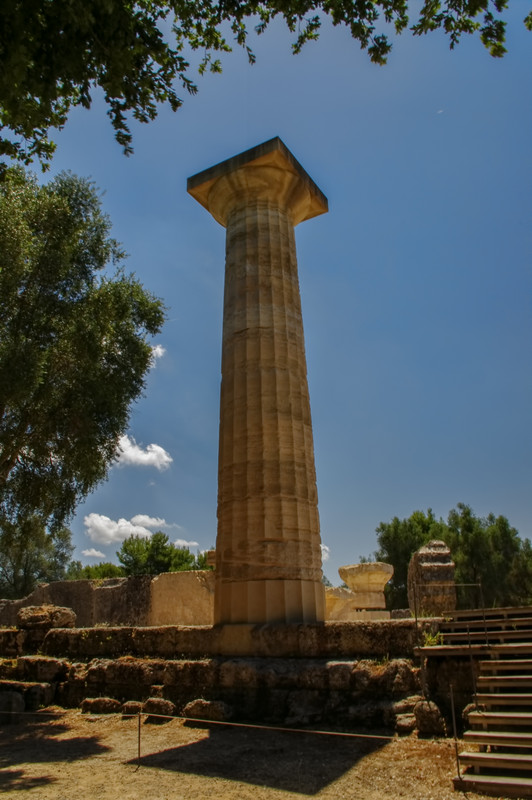
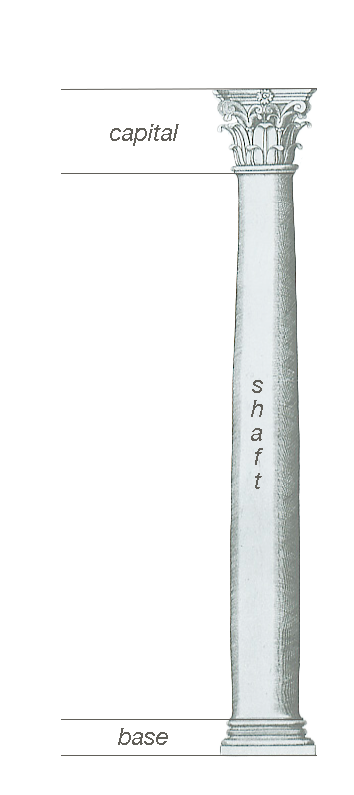
However, the similarity between columns and trees is also due to another important fact: many ancient building were also constructed using wood before the Greeks started mastering stone architecture. Naturally none of those wooden building survived, but we still have some information about them, for example we know that Greek wooden temples had cutted tree trunks used as columns, and later, when stone began to be used instead of wood, the design of the wooden columns where emulated using the stone.
Fluting
As an example you can think about the "fluting" of doric columns, it is thought to be an imitation of a feature that was typical of wooden columns. Wooden columns were indeed "fluted" because the Greeks used a scraper to strip off the bark from the trunks which left those marks on the shaft of the columns... Beside this, fluting has also other purposes, as an example it creates lights effects which enphasize the "rotundity" of the column, but it also helps to de-enphasize the horizontal joints which can be seen on the shaft since stone columns are often made with multiples cylindrical blocks instead of a singol block, for convenience and manufacturing reasons.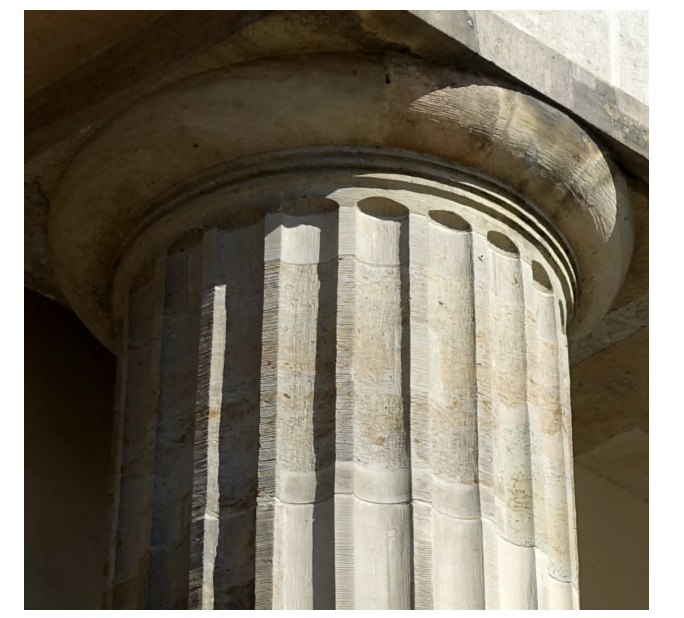
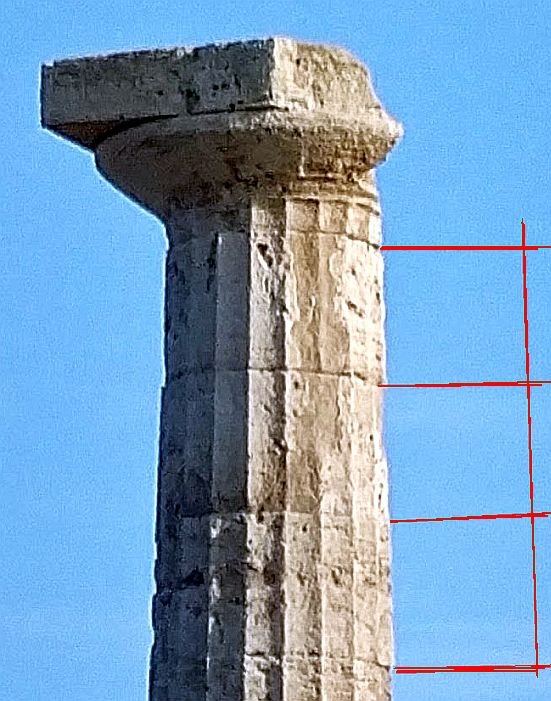

COLUMNS and ENTABLATURE
Columns are vertical elements designed to sustain something, as such, they must be matched with an horizontal element which is called entablature. Columns and entablature create a basic static structure which reminds somehow a table: the columns are the legs and the entablature is the flat surface of the table:

This structure is indeed a basic self-standing structure which actually derives from the so called "post and lintel" system, one of the most primitive building stystems used by mankind since prehistoric times; the most famous examples are the structures of Stonehenge. Post and lintel system is identified by having vertical elements, called posts or pillars, holding up an horizontal structure which is called lintel or architrave.

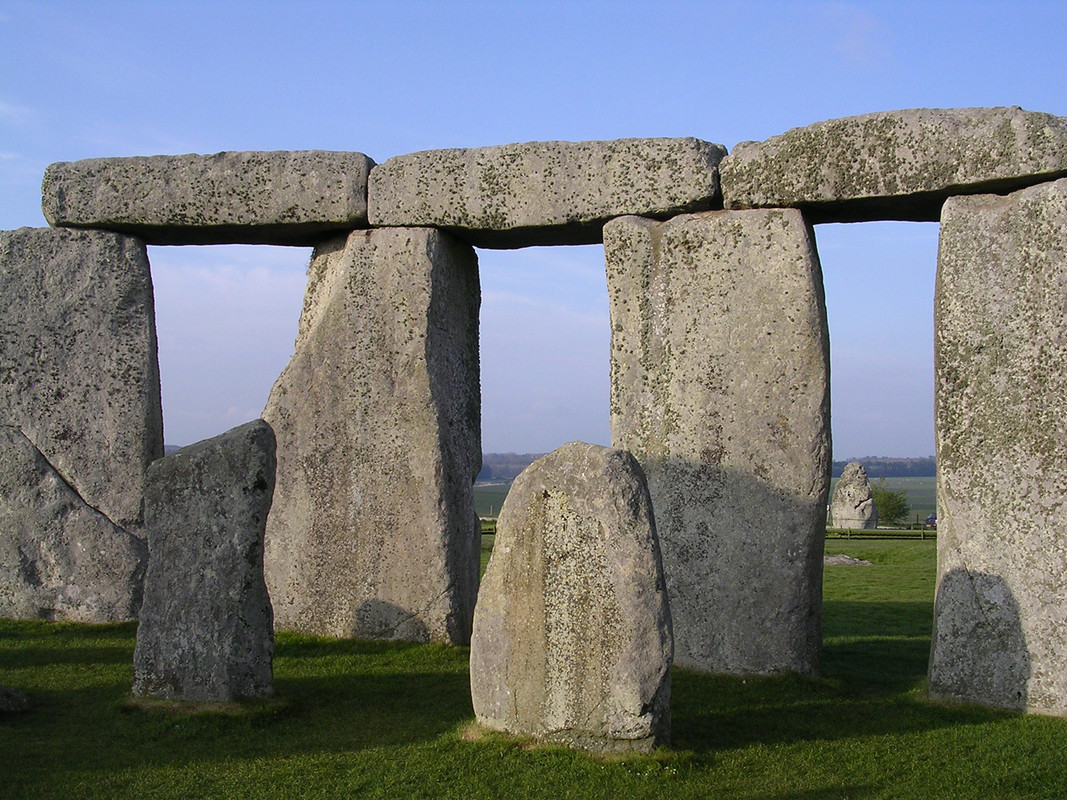

3) GREEK COLUMNS
Features and glossary
The design of columns in classical architecture evolved in ancient Greece and reached the top of its perfection thanks to Greek architects, later it was taken as a model by architects from all across the west and from all times in history, ispired by the superior beauty of the ancient design. Greek columns evolved in a variety of shapes and they where later coded with some precise rules which must be respected in order to achieve the most beautiful and balanced effect, the same can be said about classical architecture altogether... Furthermore, the are precise names for each part of the classical design, and even for each part of the column! (Which are more than you think...)I will explain briefly some of those words frequently used in classical architecture that can be useful to better understand this guide.
Column
You already know what a column is, it's divided into three main sections. The shaft is the cylindrical body of the column, it can rest directly on the floor or there can be a base at the bottom of the shaft. At the top of the shaft is a capital, it helps to mediate between the column and the weight resting upon it, broading the support surface of the column.
Entablature
The entablature is divided in three sections too. As we've see before, the architrave is the horizontal structure directly resting on the vertical supports (columns) and bearing the weight. Above the architrave is the frieze, which may or may not be decorated. Above all is the cornice, a protruding element which probably derive from previous wooden structures used to collect the rain and pour it off the roof. 
Pedestal
Sometimes columns are placed over pedestals to increase height. A pedestal is a rectangular-shaped object that supports the columns, alternatively or simultaneously it may also be added a plinth. A plinth, which comes from a greek word meaning "brick", is indeed a small square brick which can be placed below the base of the column to elevate it slightly. Pedestals and plinths can be used to alter the height of the columns without altering the proportions of anything else. (By incresing the size of the column any other element must increase in size since in classical architecture everything is made with mathematical proportion...)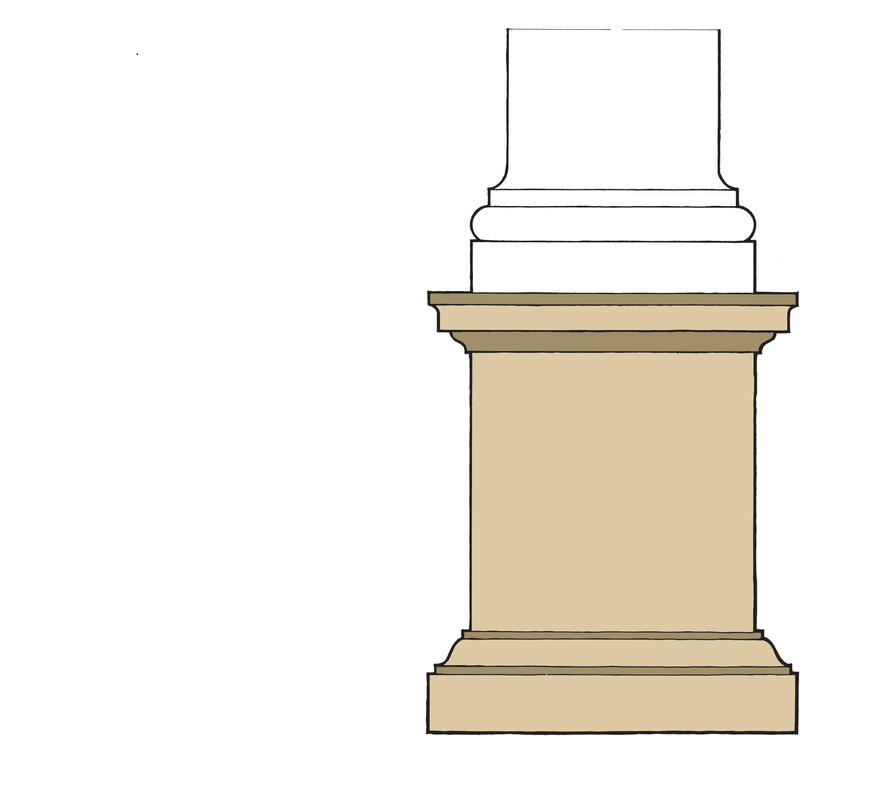
Colonnade
A colonnade is formed by several aligned columns holding up the same entablature. Columns are spaced regularly and the distance in between of each couple of columns is generally a multiple of the diameter of the columns and it's known as intercolumniation.
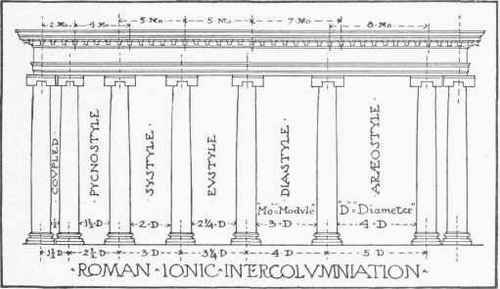
Free-standing/engaged
Columns may be freestanding or partially embedded in a wall, the last ones are called engaged columns and they are mainly a decorative elements very popular among roman buildings. Engaged columns are not fully load bearing and so they have no limits regarding intercolumniation width.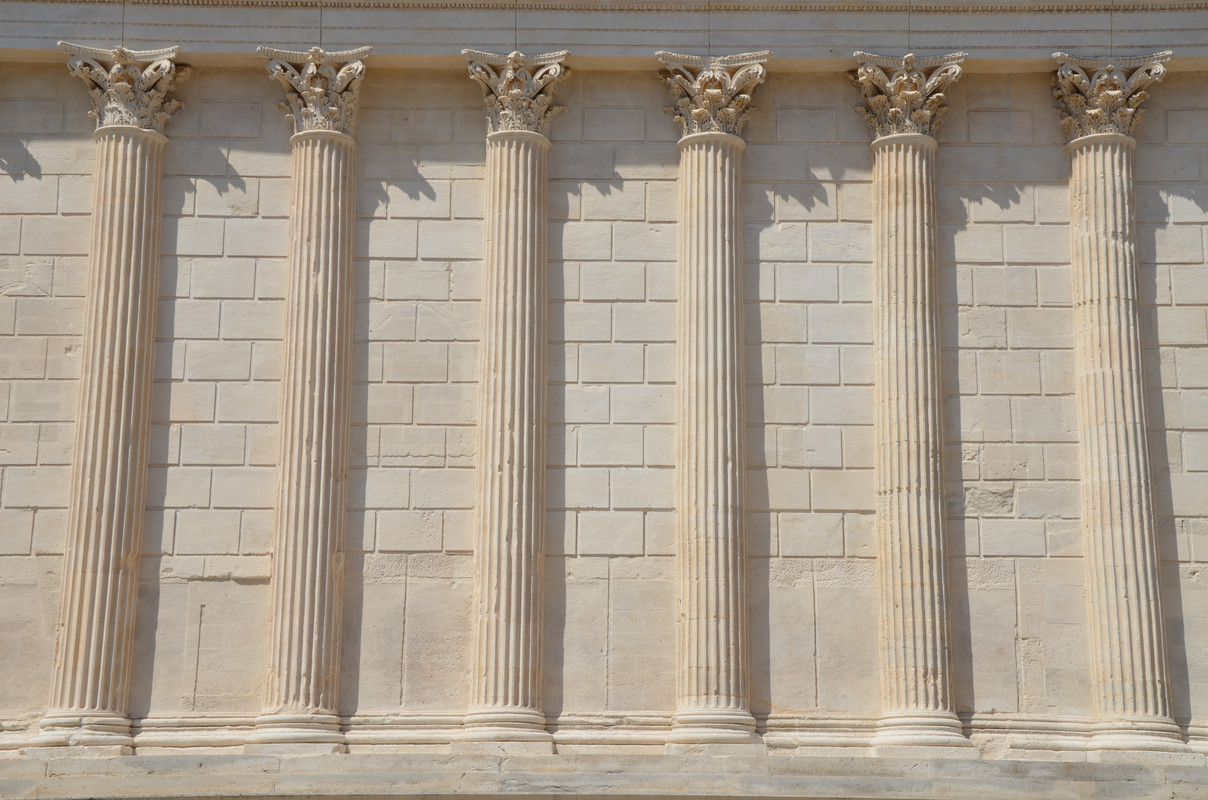
Attic
A so-called attic story is sometimes added over the entablature on top of some classical buildings, its proportions are not fixed but generally resembles those of the pedestal.
ORDERS
An order in classical architecture is a set of precise proportions and design which identifies a particular building style. The Greeks invented three orders, in different historical moments, all of which have their own design an proportion for each of the element we've seen above. They are known as the three orders of architecture: the Doric, the Ionic and the Corinthian.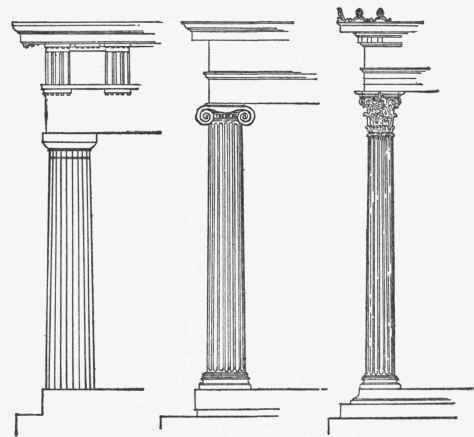

4) A GUIDE TO CLASSICAL ARCHITECTURE IN MINECRAFT
My intention is to create a guide that can teach builders to apply rules of classical architecture in the game of Minecraft, but also to appreciate the beauty and the perfection of classical architecture from a very direct and "unscholastic" point of view: by following this guide you will be able to apply classical rules to design and build your own buildings, almost like a real architect would do!First I want to clarify that with this guide I've tried to transpose rules and proportions of classical architecture in the game following two fundamental principles, which I call realism and playability. The first one is a direct consequence of applying classical rules to a Minecraft build: it will look more "realistic" of course, since it will resemble real buildings and monuments you can see around. The second principle however is not less important: a playable build must be small enough to be enjoyed in-game and it must not be oversized. Oversizing is an answer many builders tend to give in order to improve details and realisms of their build, however I think that an oversized building may be nice and valuable, but it's not Minecraft anymore, since it can't be appreciated in-game or without a rendering.
I will add further episodes to this guide in order to cover the most important parts of classical architecture, however the basis for any further discourse about classical architecture are represented by the subject of this first episode: columns and orders. It's important to master design and proportions of classical orders and all related elements because they represent the fundamental matrix used to shape any classical building... So you can't miss this episode if you want to understand those that will come later!
COLUMNS IN MINECRAFT
To begin with it should be noted that there are several ways to reproduce columns in Minecraft, but this guide will be about two of them, which i call standard (1) and monumental (2). These two "formats" are based on the size of the columns and they are enough to reproduce in Minecraft the maiority of real buildings. A standard column is simply made with one block while a monumental column has a 2x2 shaft, making it considerably bigger. Due to the nature of Minecraft, monumental columns can be richer in details and shapes than standard columns, however, in order to build in a realistic and playable way, monumental columns should be considered fairly big and they can't fit for any construction but the most grand. In particular, standard columns should be used for any small or medium sized building (3) while monumental columns fits for very large and monumental buildings, especially those with a single story as the Greek temples (4).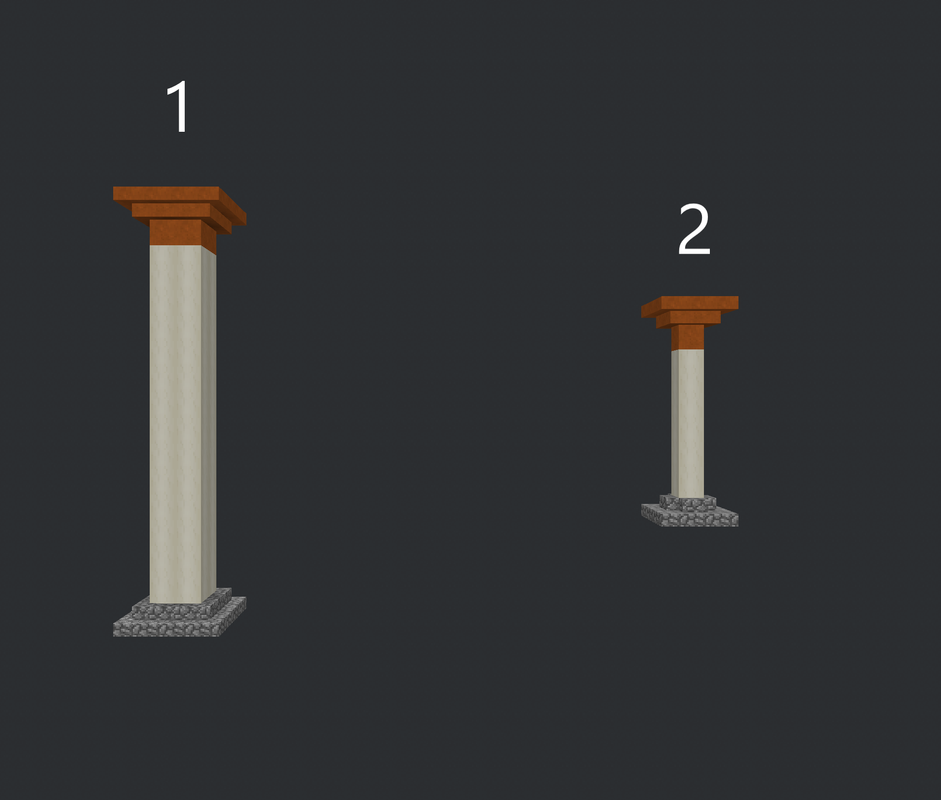
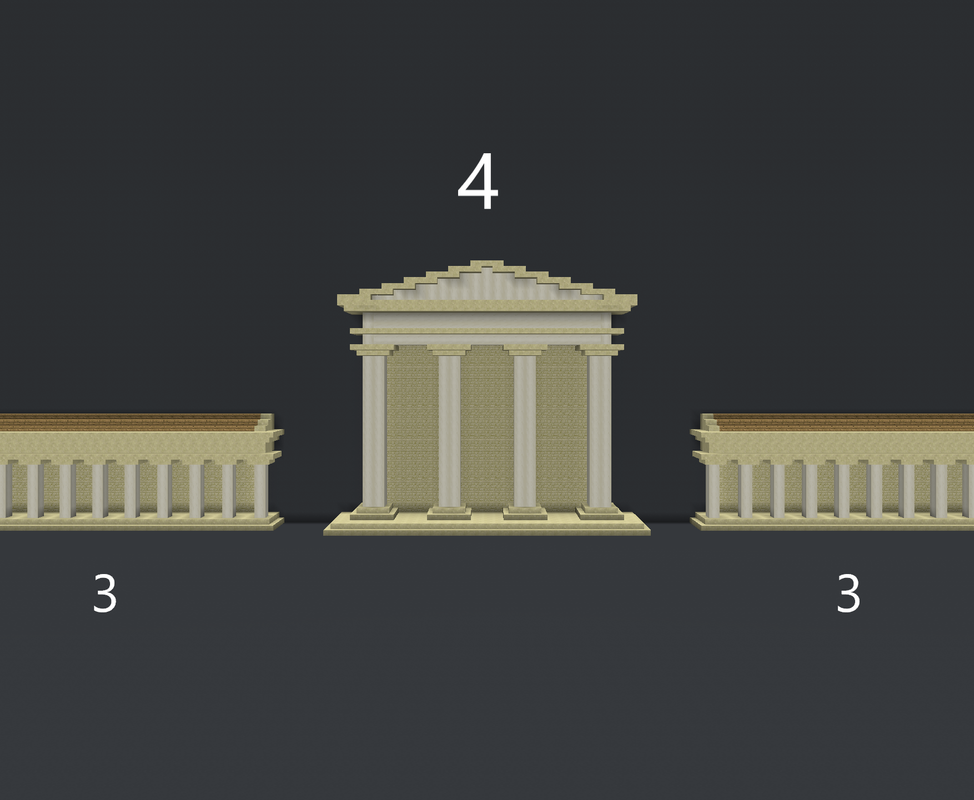
Rules of classical architecture can be applied to both standard and monumental columns; however this guide will be mainly dedicated to monumental columns since standard columns are pretty intuitive and simple, even though they are more common.
Base
Columns may or may not have a base. Monumental columns usually have a base made with stairs while standard columns usually don't have a base since a base made with stairs would be too big and looks like an "enourmous shoe" for a small foot...
Capital
A capital is generally made with stairs placed upside down both in standard and monumental columns, we will see later which types of capital are possible. It's advisable to make the capital with a slightly different color in order to distinguish it from the shaft.Entablature
The height of the entablature for a generic colonnade should be 1/4 the height of the columns (1). For example, the entablature for monumental columns which are 16 blocks high should be 4 blocks high while the entablature for standard columns 8 blocks high should be around 2 blocks high. The proportions of architrave, frieze and cornice, however, may differ depending on which order is used.
Pedestal
Columns may also be placed over a pedestal to increase height. The proportion for a generic pedestal should be 1/3 the height of the column (2). Monumental columns can be made with fancy pedestals while unfortunately it's hardly possible to build a correct pedestal for a standard column. 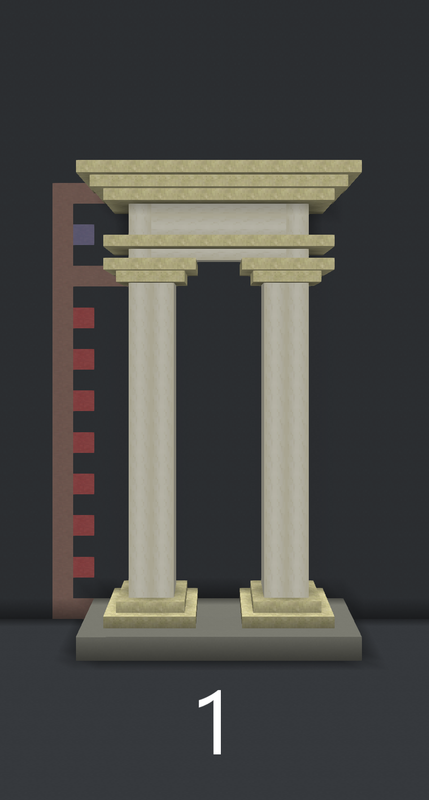
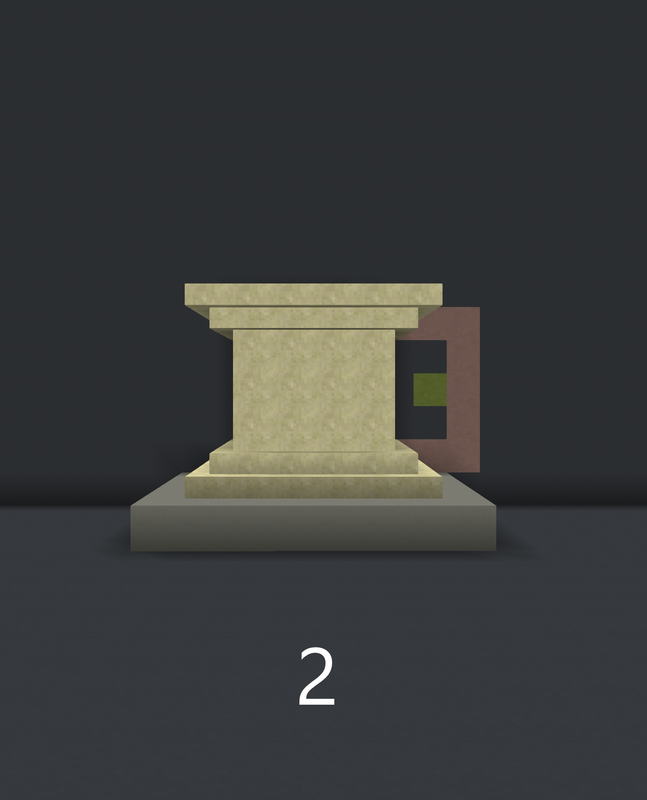
DORIC ORDER
The Doric order is the most ancient of the Greek orders. It's a steady and sober style which expresses strenght and solidity. Very powerful if used well.When should I use this order?
Doric order is an expression of strenght and solid morals, its simplicity is its greatest virtue.
Doric columns have a standard proportion of 1/8, meaning that their height is eight times their diameter. For example this means that a standard Doric column will be 8 blocks high while a monumental Doric column will be 16 blocks high.
The Base/height ratio sometimes may be lower as 1/7 or 1/6 depending on different styles.

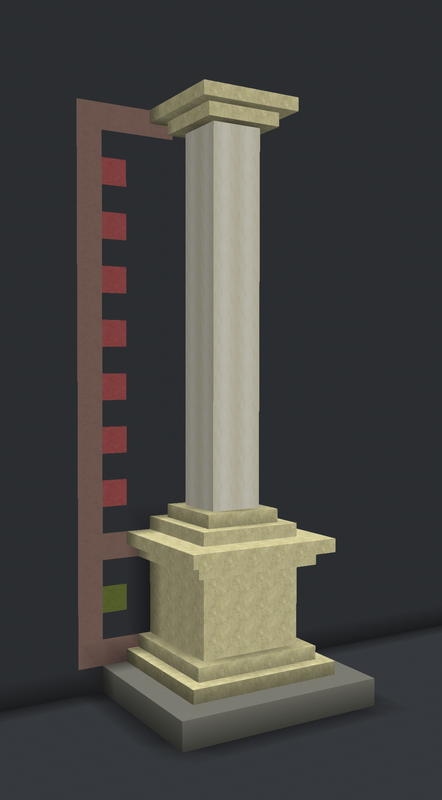
Doric columns may have a base especially in Roman buildings but they almost never have a base in Greek buildings. They same thing can be said for the pedestals.
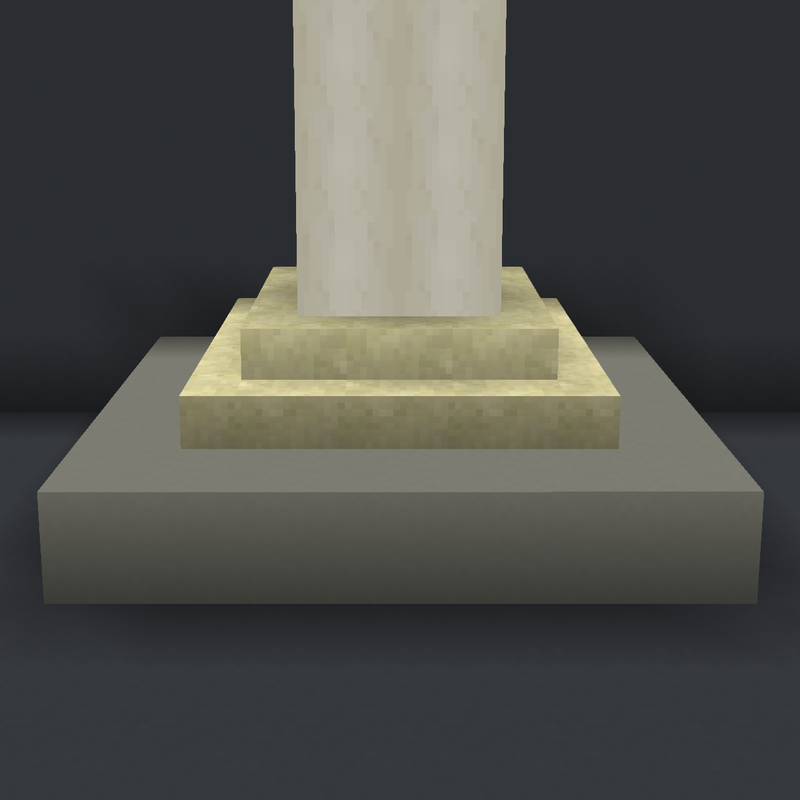
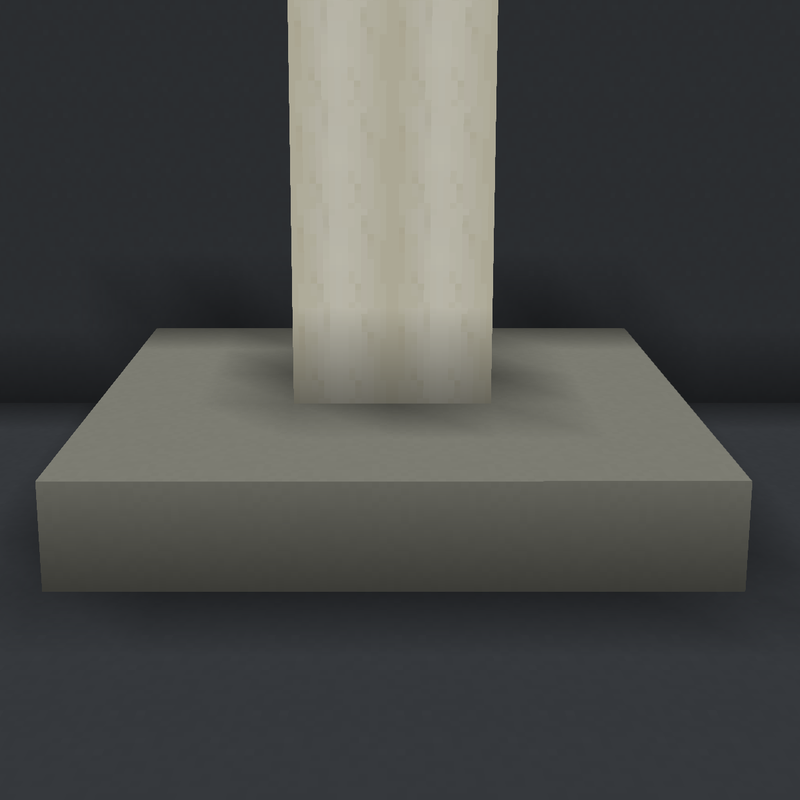
Doric entablature for standard columns can be 2 or 2.5 blocks high depending on which style you chose: without slabs (1) or with slabs (2). In the style "with slabs" the entablature looks thicker and the capitals look thinner.
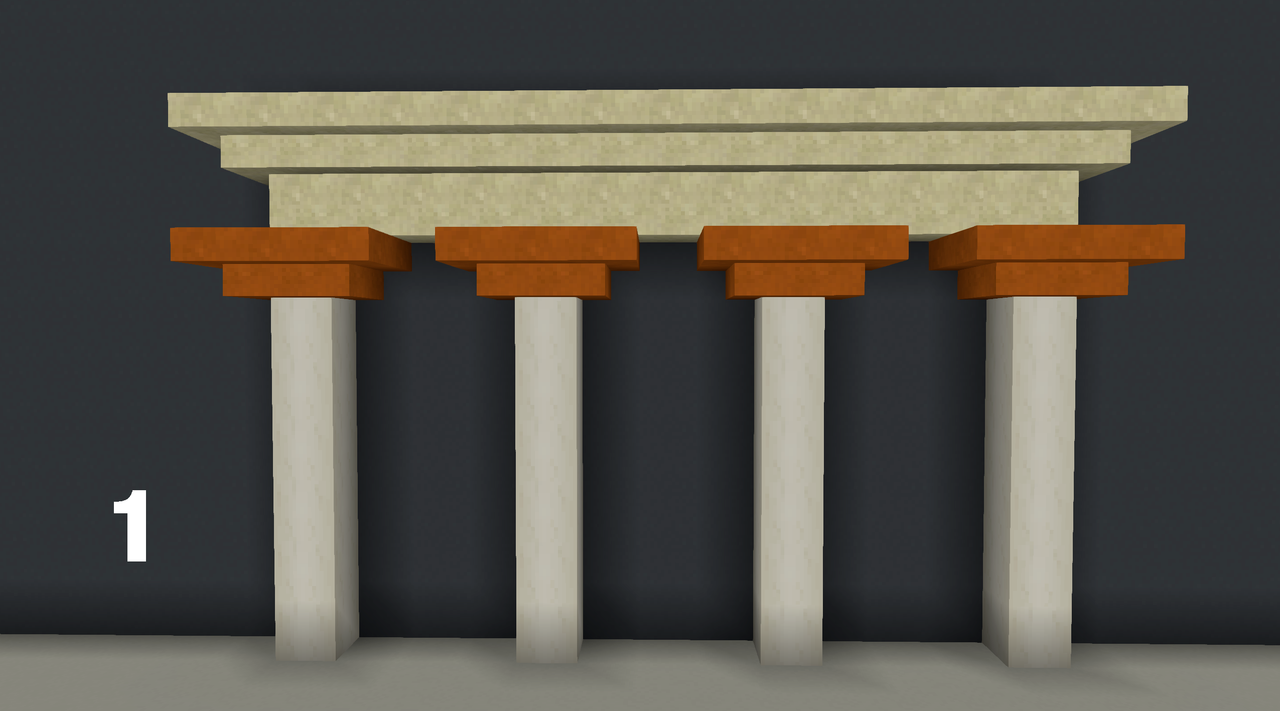
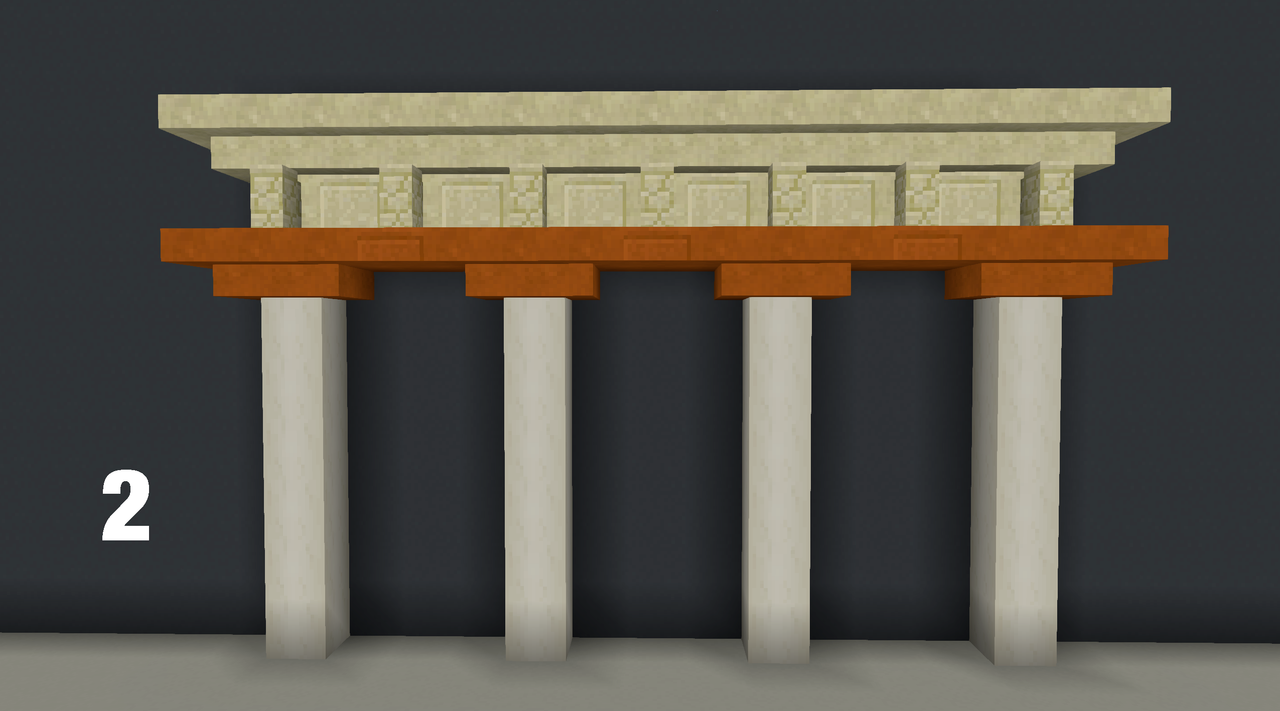
At a standard scale the architrave and the frieze are basically the same thing, but in the version "with slabs" the frieze is somehow more distingushable from the architrave.
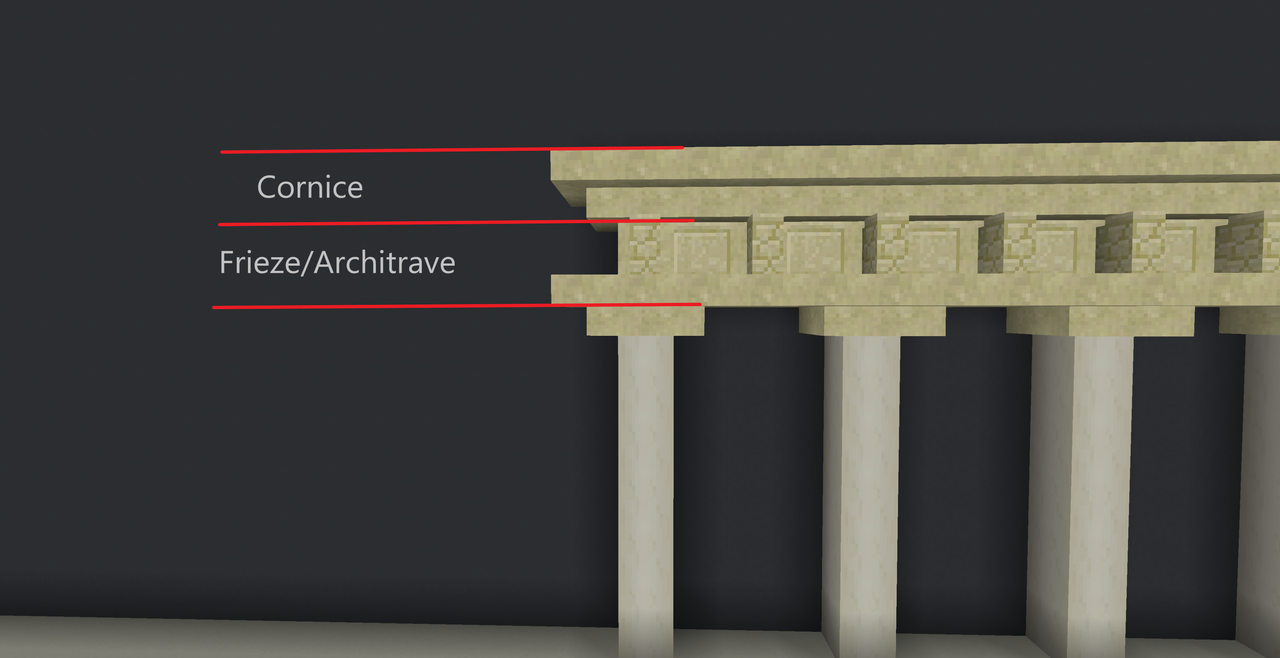
When possible it's advisable to add the typical decoration of Doric frieze: triglyphs and metopes. Triglyphs in minecraft are basically pieces of wall, as a rule they must be aligned with columns and they must be arranged in-between columns with a regular and simmetric pattern (just one in the middle in this case). Metopes (singular: metopa) are placed alternately to the triglyphs and they must be square-shaped. I call the previous one the "Doric rule".

Doric entablature for monumental columns is 4 blocks high and it's divided in three sections with precise proportions: 1 block for the architrave, 2 for the frieze and 1 for the cornice.

The frieze and the architrave are on the same depth level while the cornice is always made protruding outward. Architrave and frieze may be divided by a protruding line called taenia which is not alway present; you can see it highlighted below.

Since the Doric order is the most ancient and it was used for so long, there are many changings which occured in its design during history, these design may also be reproduced in Minecraft as different. For example a common and simple entablature good for the Doric order and used mainly by the Romans has no metopes nor triglyphs for the sake of simplicity and versatility. This entablature can be referred to as "Tuscan" entablature (1) and it has a slighlty different division between the three sections (1.5 blocks for the architrave, 1.5 for the frieze, and 1 for the cornice). Triglyphs can be added to this entablature as well (2). In order to highlight triglyphs and metopes the standard Doric entablature I've used in this guide have an expanded frieze (1 block for the architrave, 2 for the frieze, and 1 for the cornice); metopes are also wider. You can see this entablature down below (3) and in the images above. The downside of this entablature is that the frieze may look unproportioned, to balance it one level of thickness can be added to the architrave creating and entablature whose overall height is 5 rather than 4 (4). Particularly thick entablatures are also tipical of ancient Greek Doric buildings.

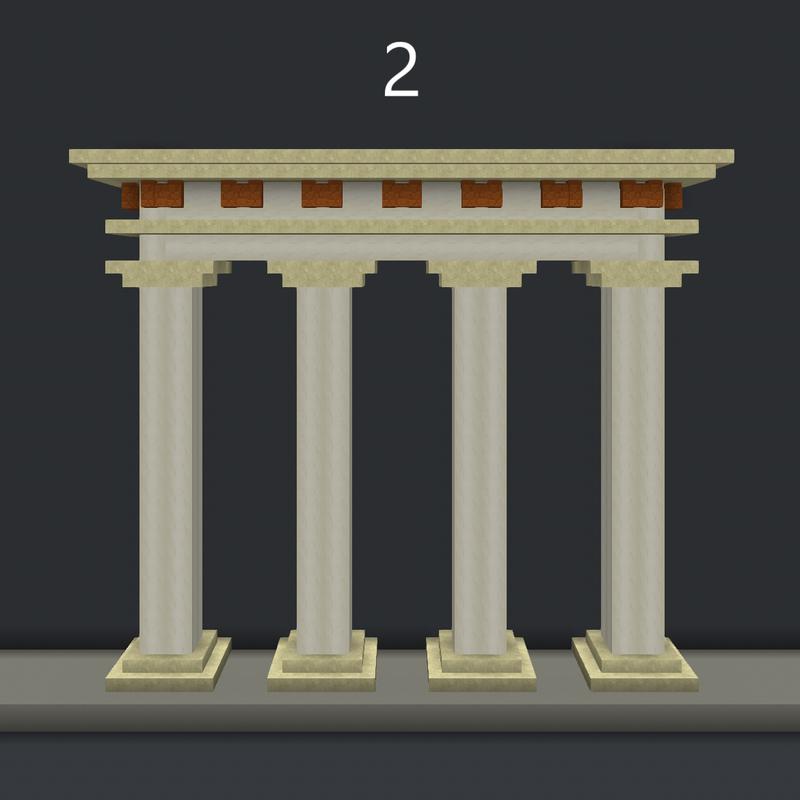

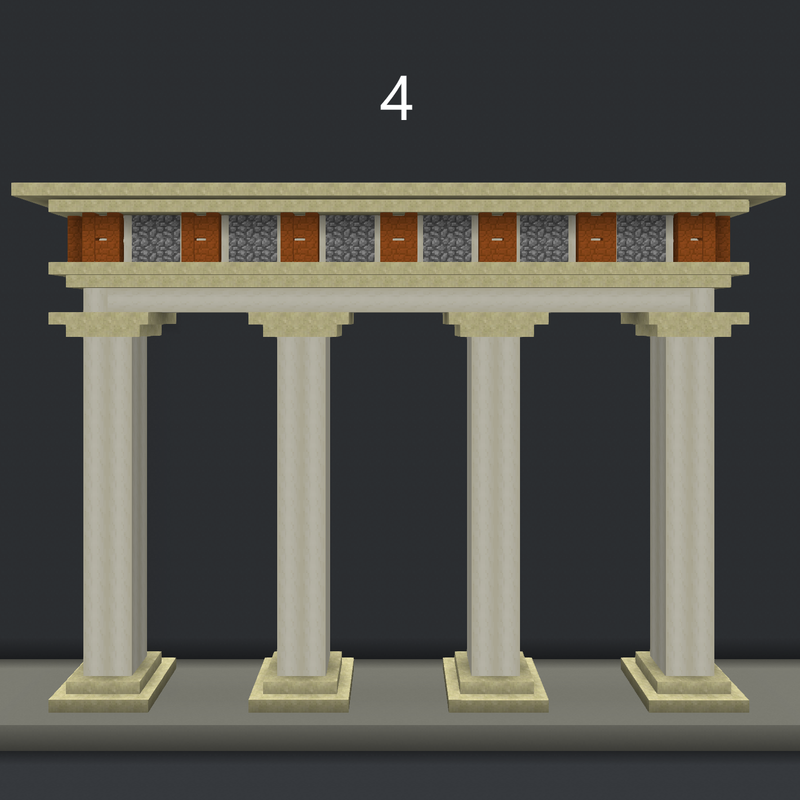
Triglyphs and metopes used at monumental scale respects the same rules seen earlier, however triglyphs may come in two different shapes which I call half or full.
Full-triglyphs are 2 block wide and they are always aligned above columns. Half-triglyphs are 1 block wide and they can be used in the space in-between each couple of columns for convenience: they allows uneven spacings of the columns which can be useful in game.
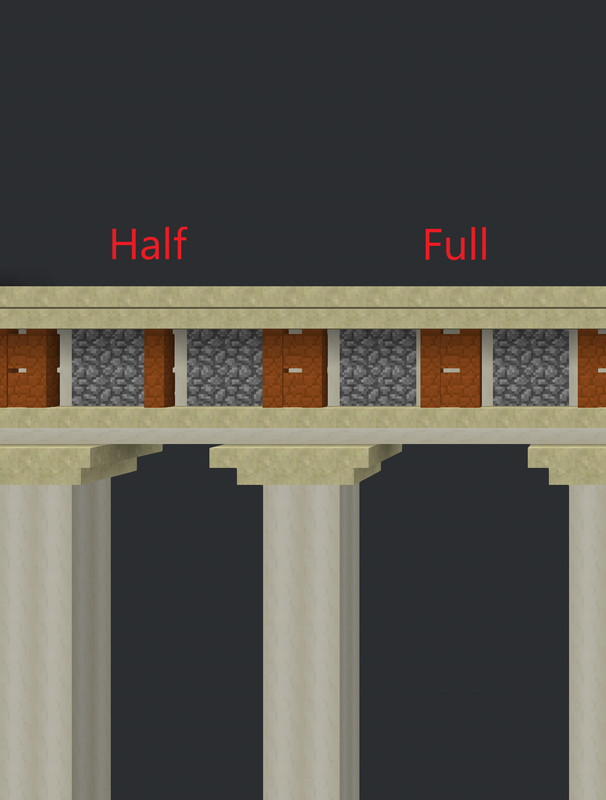
Doric intercolumniation is based on the number of triglyphs in between of each couple of columns rather than on the distance of columns from each other, so it's rigid and it cannon change freely, in other words, in the middle of each intercolumniation there must be a triglyph or more triglyphs arranged with a regular and simmetric pattern, distance between triglyphs cannot change and must be regular, that's why the intercolumiation is "rigid", unless you chose the Tuscan entablature.
1) Coupled columns are as close as possible; not so common in the Doric order (certainly not during the antiquity).
2) Monotriglyphic intercolumniation is made with a single triglyph in the middle of each couple of columns and it should be considered the doric standard.
3) Monotriglyphic with full-trygliphs.
4) Di-triglyphic intercolumniation has 2 triglyphs in the middle of each couple of columns, however it's too wide to be used in most situations except with engaged columns as we will see later.
5) Di-triglyphic with full-trygliphs, as for the previus one but even more so...
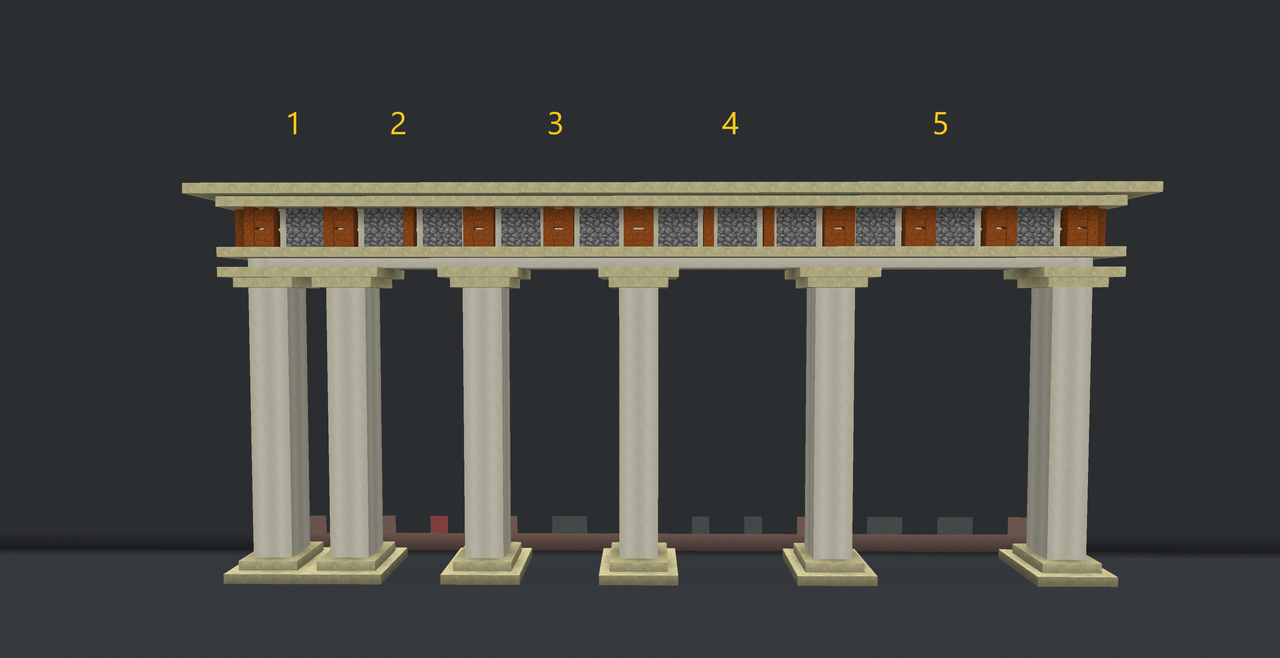
Tri-triglyphic and tetra-triglyphic intercolumniation are also possible but very rare.
IONIC ORDER
The Ionic order brings with it the soft curves of the volutes. Compared to the Doric order it's more slender and somehow, it's a very elegant style and probably the most balanced.When should I use this order?
Ionic order is an expression of balance and equilibrium, it keeps some of the virtues of the Doric order adding a classy and elegant personality.
Ionic columns have a standard proportion of 1/9 but sometimes they can be a bit thinner (1/10) or stockier (1/8 or 1/7).
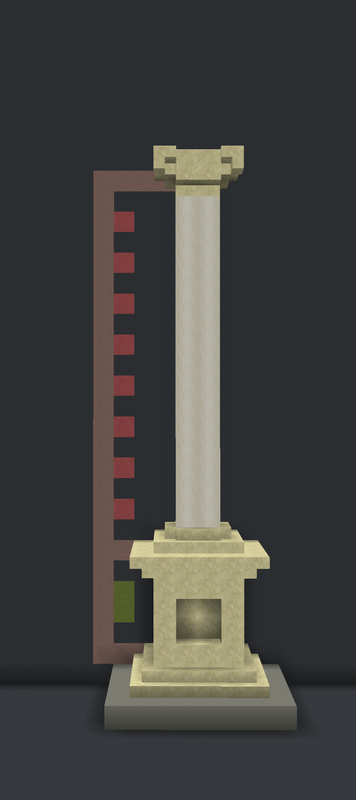
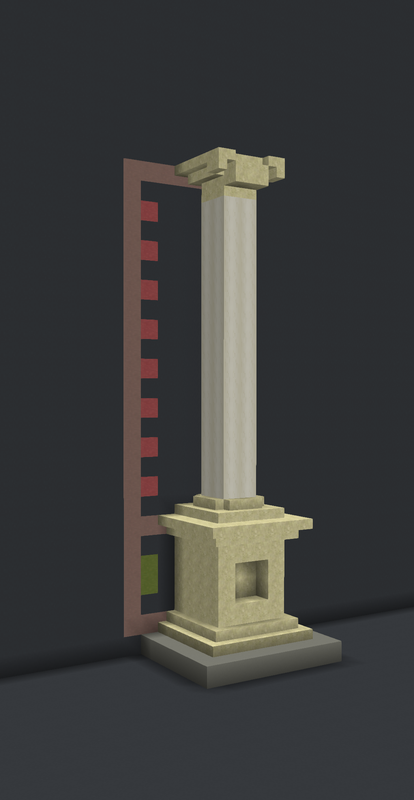
The capital is made with two volutes (spirals) made with reversed stairs and some slabs.
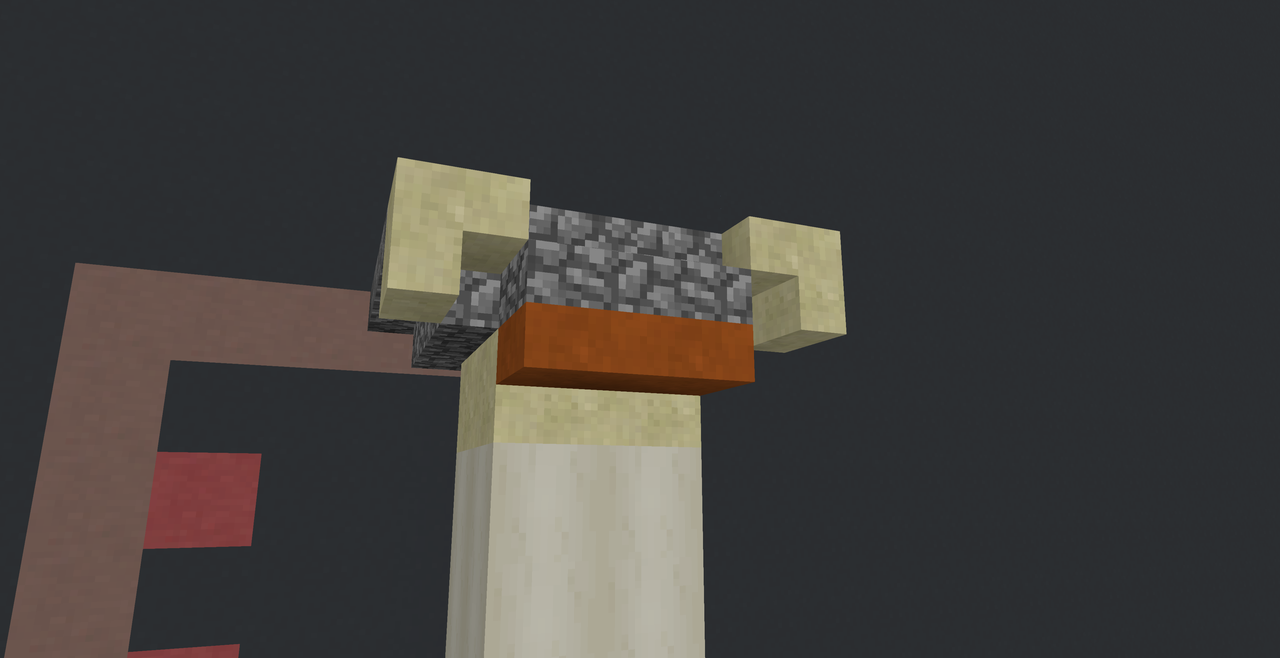
There can be 4 volutes if the column can be seen also from the rear but I don't recomend to add them because they worsen the look of the column from ahead.
At a standard scale Ionic columns can be made as you can see in the following picture, respecting Ionic proportions.
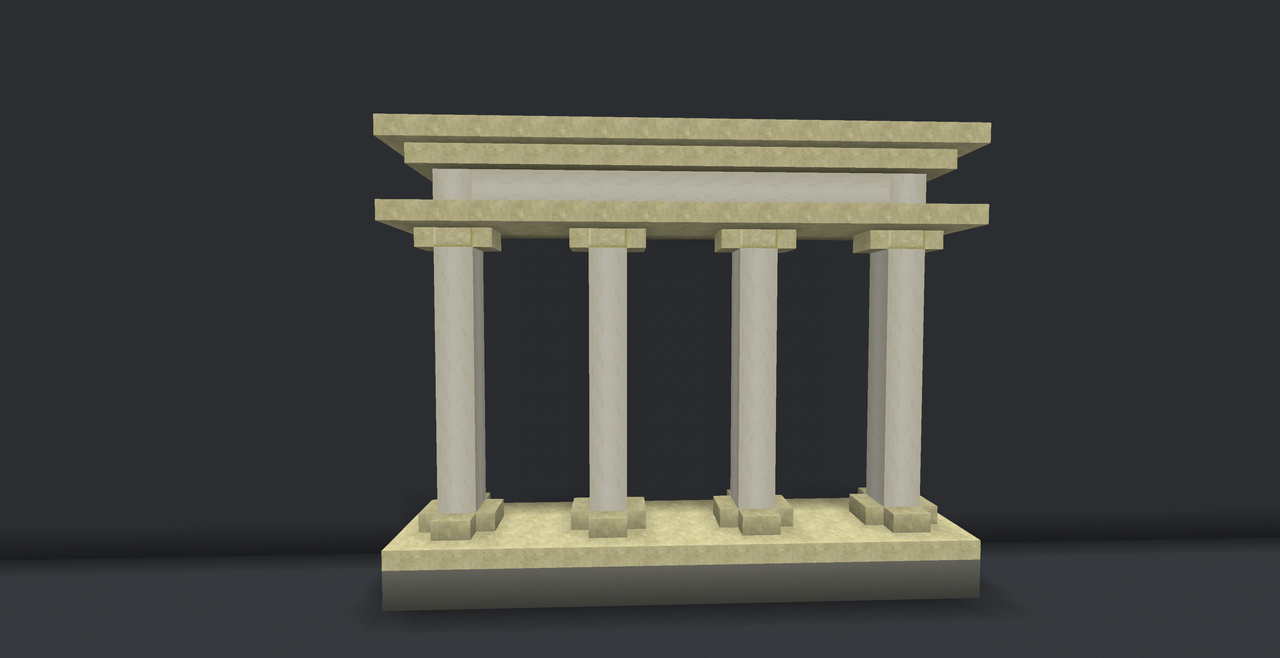
Ionic columns always have a base. Bases can be simple or more elaborated, sometimes even sculpted.
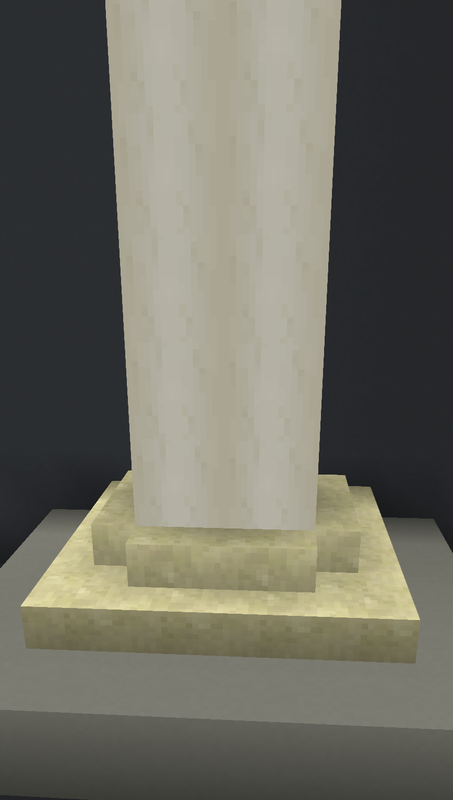
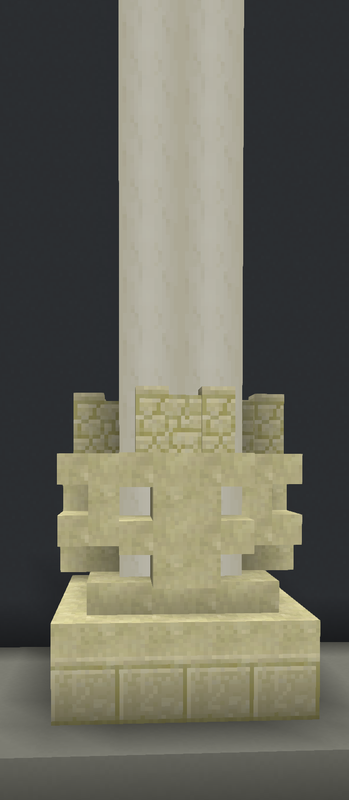
Ionic entablature for standard columns resembles the one seen before for Doric columns, except for the fact that it hasn't got triglyphs nor metopes. Regarding monumental columns Ionic entablature is thicker (5 blocks) and it's divided in the following way: 1.5 blocks for the architrave (one block and a slab), 1.5 blocks for the frieze, and 2 blocks for the cornice.

The cornice is decorated with dentels in its lowest section, which you can see highlighted in the following picture.
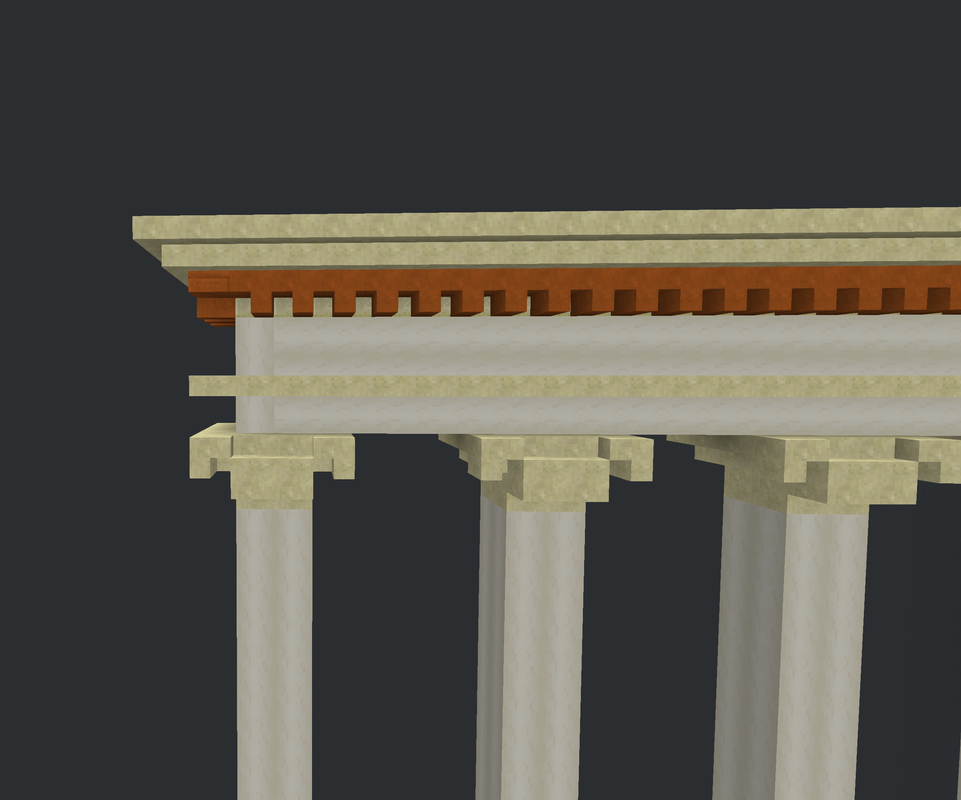
Ionic intercolumniations are based on the diameter of the columns, considering that a monumental columns have a diameter of 2 while a standard columns of 1.
1) Coupled
Columns are as close as possible to each others, they may also be called "paired" or "twinned" columns. The bases and capitals of the columns must be touching, so it's 2 blocks spacing for monumental columns and 1 block for standard columns (1 diameter).
2) Pycnostyle
This intercolumniation is the narrowest possible for a walkable colonnade, meaning that it can be walked through with relative ease. Columns are 1.5 diameters apart, so it's 3 blocks for monumental columns but it's not possible to reproduce this intercolumniation with standard columns.
3) Systyle,
Columns have 2 diameters spacing so it's 4 blocks for monumental columns and 2 blocks for standard columns. It's considered to be a standard narrow intercolumniation.
4) Eustyle
This spacing can be considered the most balanced and visually satisfying version for monumental columns. Columns are spaced 5 blocks apart.
5) Diastyle
Columns have 3 diameters spacing. It's considered to be a standard wide intercolumniation.
6) Areostyle
Any intercolumniation wider that 3 diameters is called in this way. This spacing is too wide for stone colonnade since the architrave would break up, however it may work for engaged columns or if the architrave is not made of stone. (Provided that you want to build in a realistic way...)
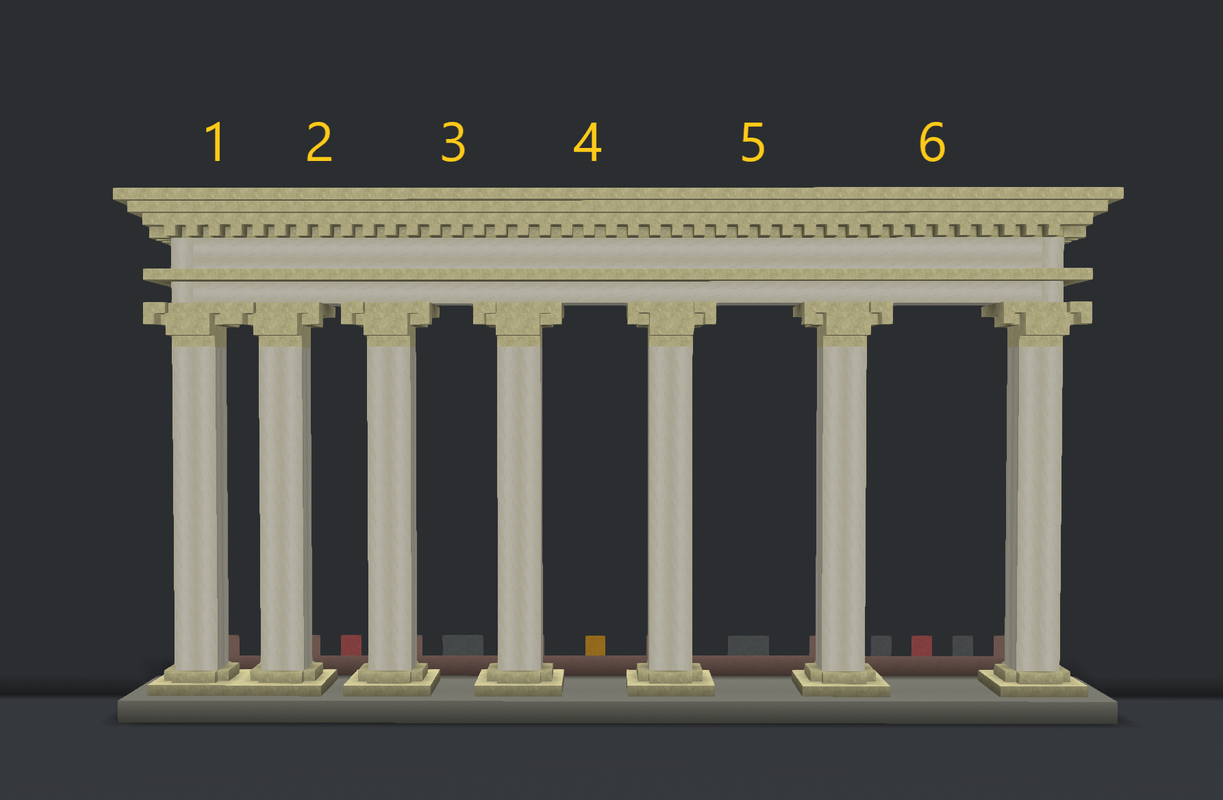
CORINTHIAN ORDER
Corinthian order has much in common with the Ionic, but its leafy capital is particularly eye-catching, making this style the most showy and rich.When should I use this order?
This order is clearly an expression of flamboyance and ostentation, it was indeed preferred by the Roman, it's the most rich order and it gives its best if it's not abused.
Corinthian columns have a standard proportion of 1/10, the ratio can vary between 1/7 and 1/11+ (rare).
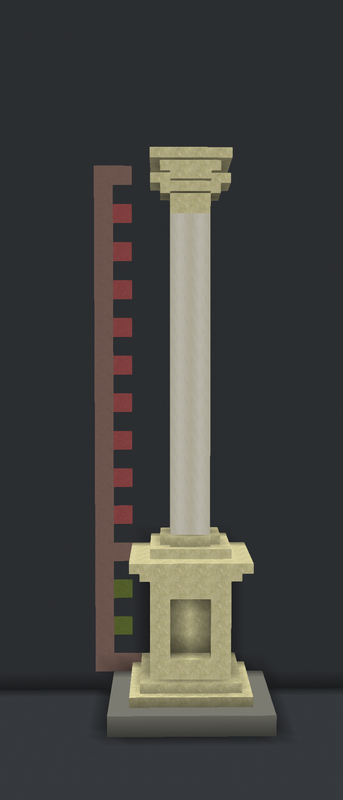
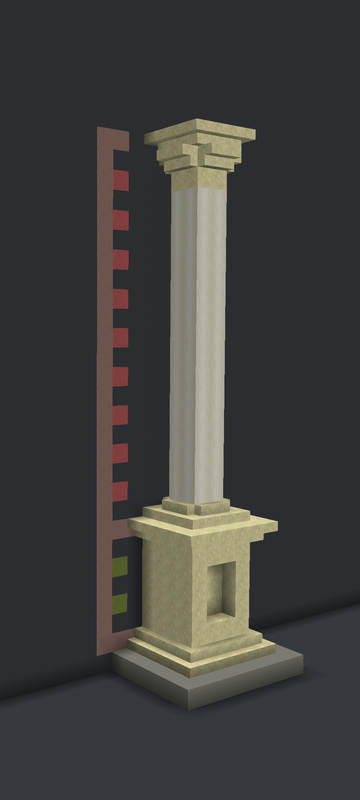
The capital of Corinthian columns is made with reverse stairs. It can be made in several other ways I've seen from other builders but generally there's not much difference. However I think that one noteworthy variant is represented by the composite capital, which is basically an hybrid between Corinthian and Ionic capitals; it's a very popular innovation introduced by the Romans.
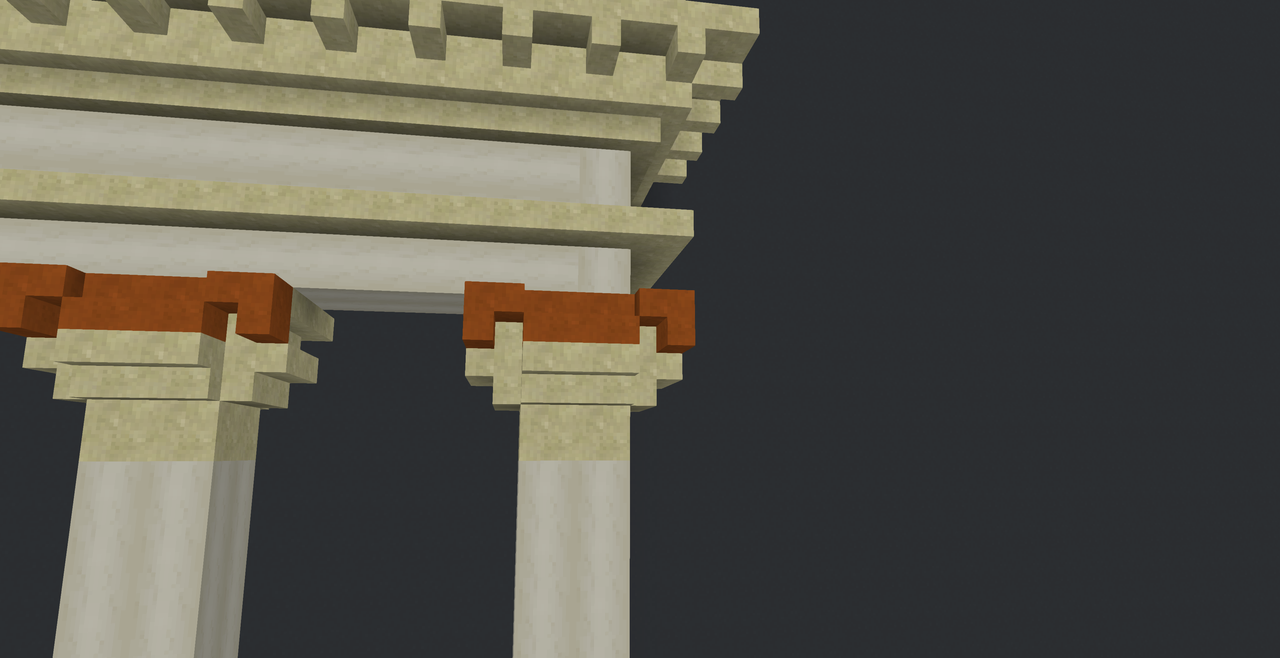
The Corinthian has much in common with the Ionic order, for example both have always a base, but they also share the entablature and other features which have the same proportions in both orders. The Corinthian entablature however has a variety of decorations which can be used for the cornice beside Ionic dentels.
1) Modillions
Modillions are the classical Roman decoration and they are placed in the upper section of the cornice. They are made alternating reversed stairs and slabs (2 stairs and 1 slab). Modillions may not be suitable if the entablature has many angles although they are versatile enough, in any case you have to make the corner in the correct way when possible. (See below.)
2) Dentels
Dentels are the standard greek Ionic decoration.
3) Minecraft "hybrid"
This decoration is somehow a mix between the last two and it basically made placing modillions in the lower section of the cornice. I've used this decoration many times in my builds since it has a nice effect in game, it take somehow advantage of the qualities of the last two.
4-5-6) Block modillions
Block modillions can come in many shapes and they are one of the most simple decoration, nevertheless they can be very effective. They are good for "rustic" designs but they can also be used effectively if the entablature has many angles since it pretty easy to make a corner with them.
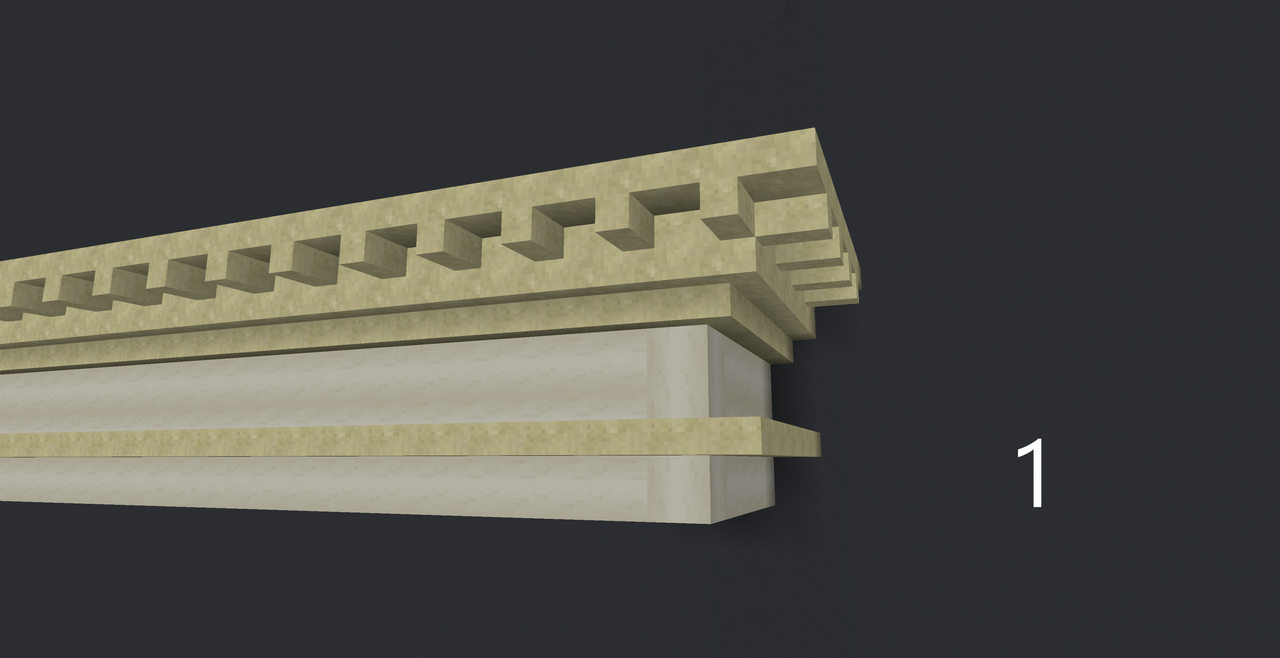
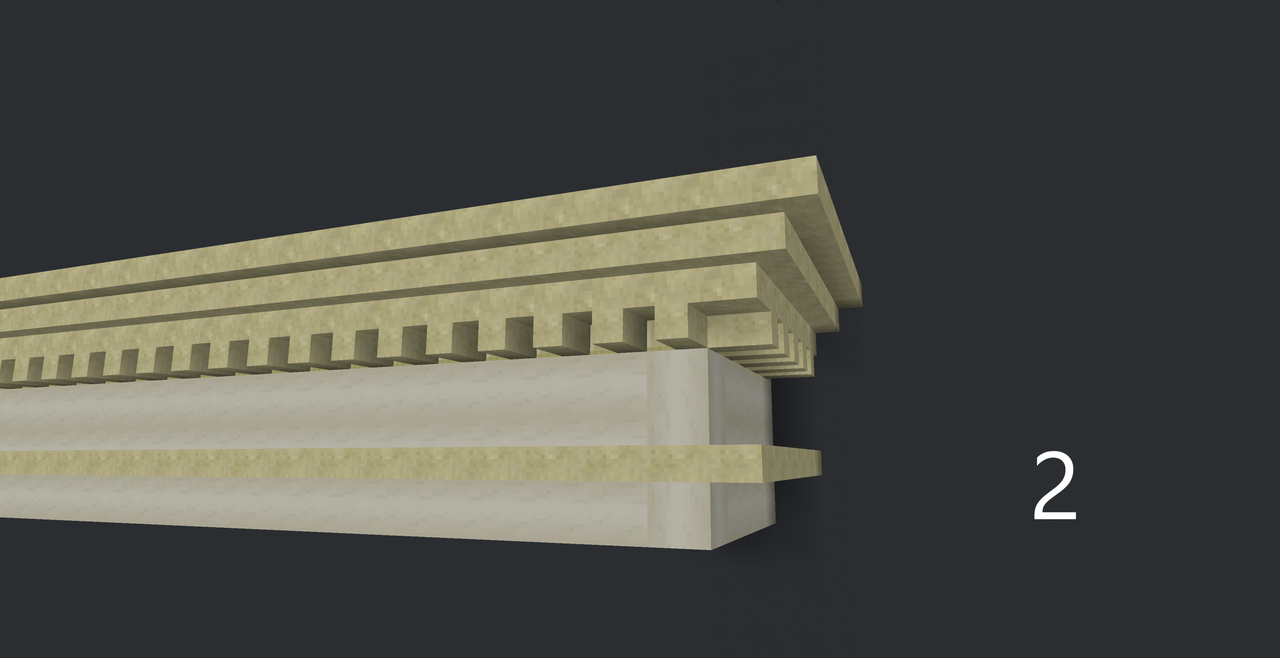
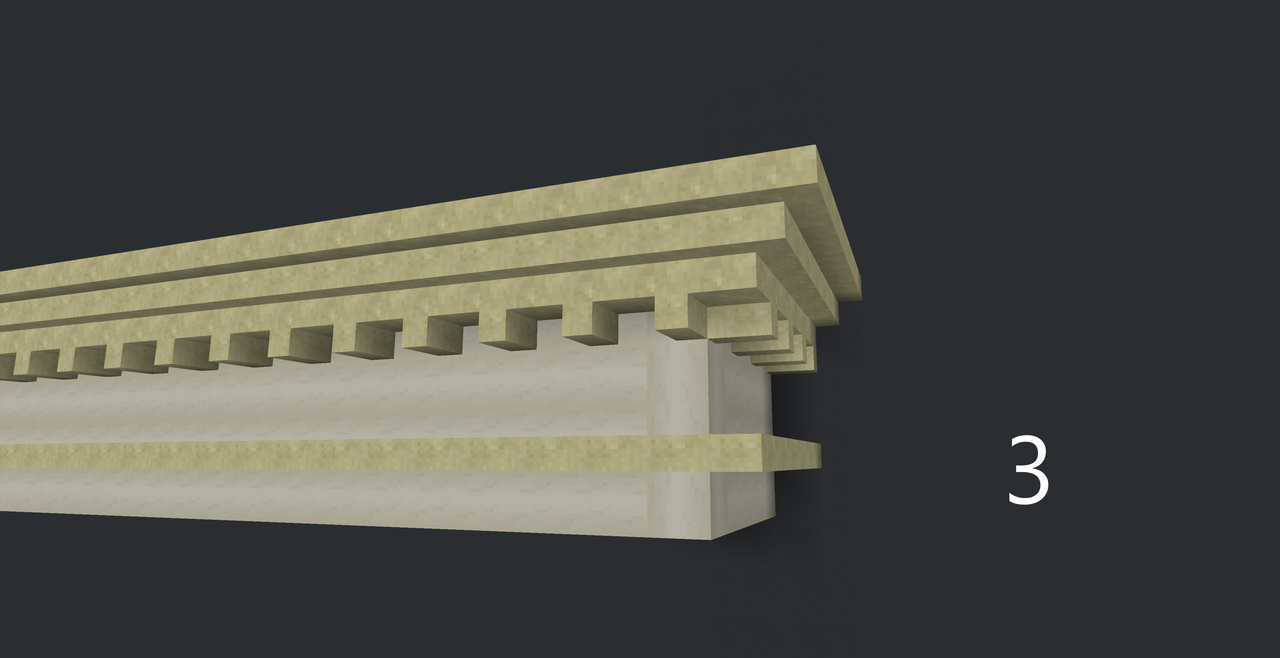
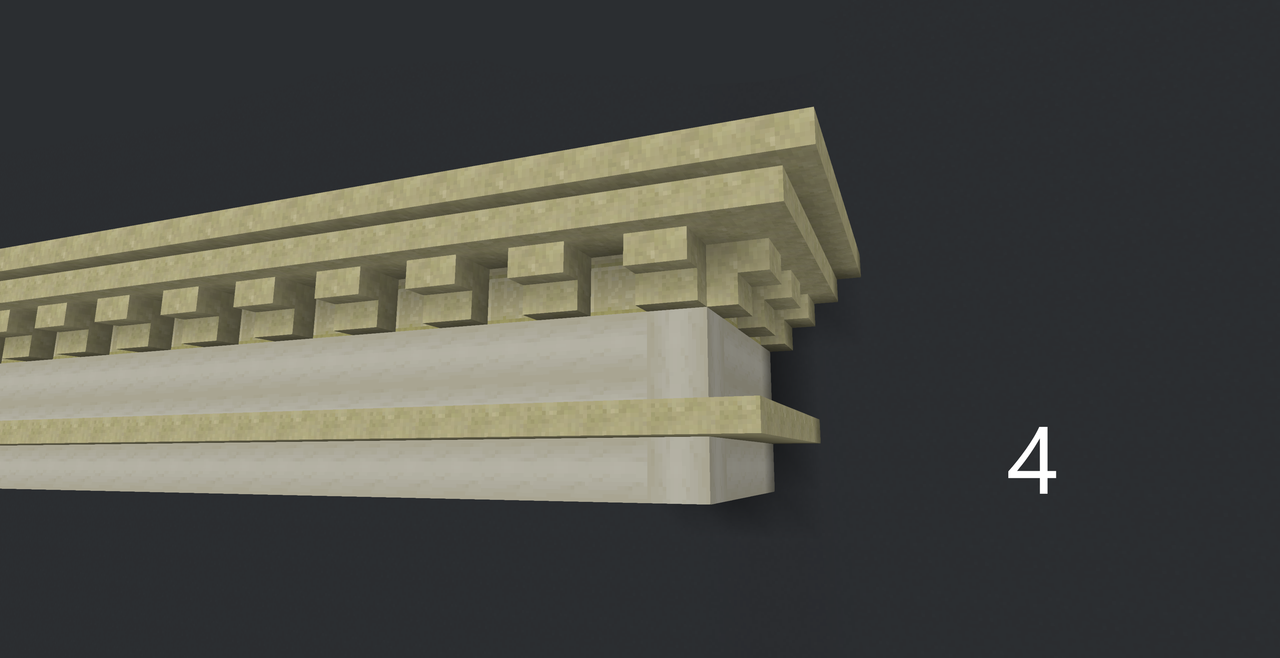

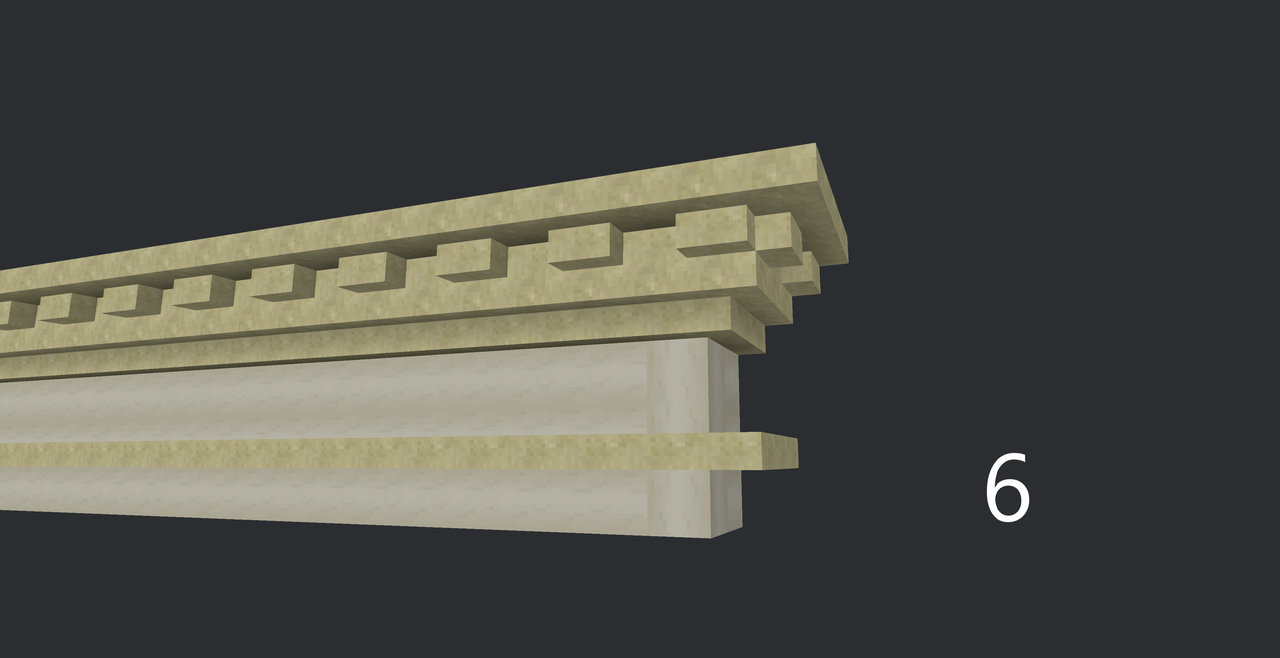
All these decorations may also be used for Ionic colonnades but it's rarely appropriate.
Corinthian intercolumniation is the same as the Ionic intercolumniation.
Engaged columns
Engaged columns can be made with monumental columns by embedding half the column in a wall (1), in this way columns have no limits regarding intercolumniation width since they are not fully load-bearing any more. With standard columns it's impossible to have half a column since the shaft is made with a single block, in this case, engaged columns are made by placing a wall right behind the columns so that the columns touch the wall (2).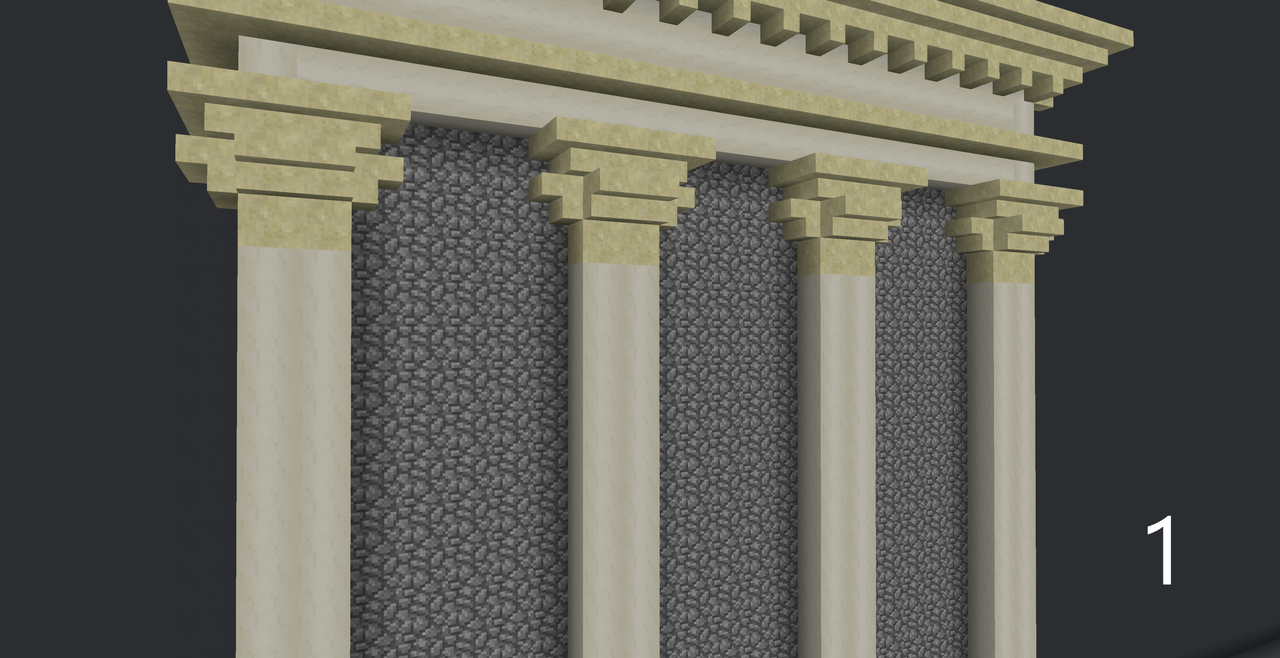
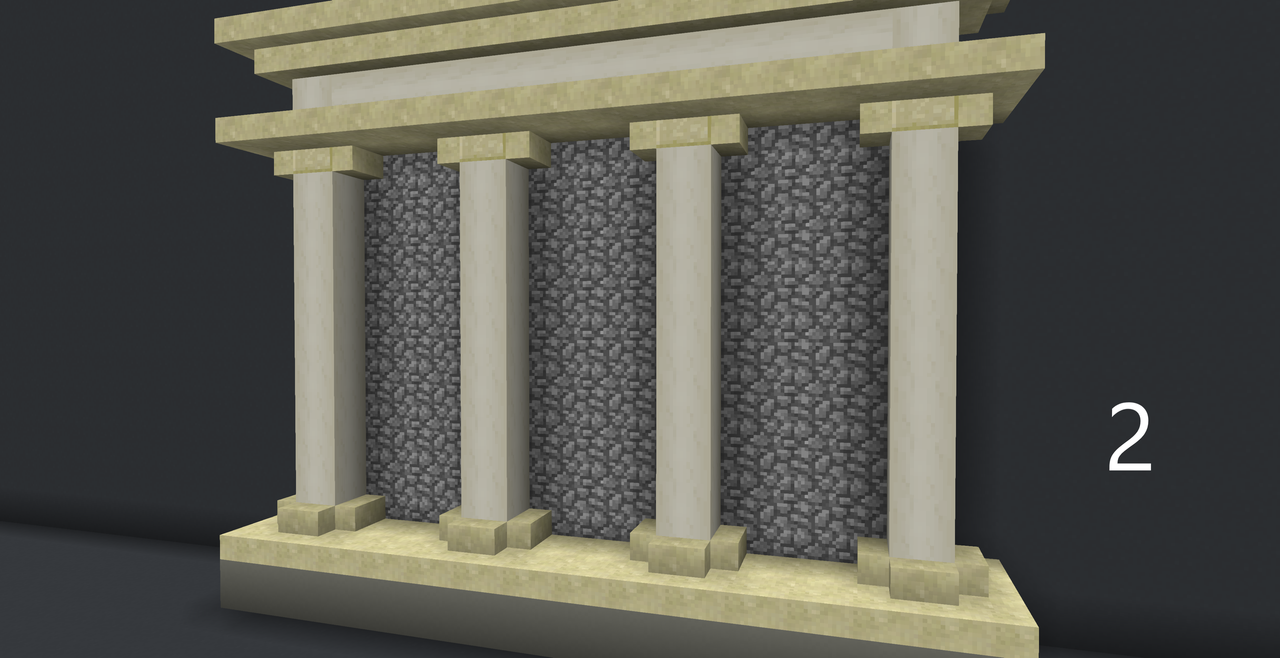
SUPERPOSED ORDERS
It may happen to have different orders being used together in the same building, in this case there are some rules to respect. You may have already noticed that different orders cannot be mixed at random since each one has different proportion rules which cannot be respected simultaneously, however it's possible to use different orders for different floors of a building and this happens very often. The only rule which has to be respected in this case is simple: Corinthian must be above Ionic which must be above Doric, it's never mandatory to use all the three orders but in any case you can't reverse this layout. For example a building with one floor upstair can be designed with Doric at the ground level and Ionic at the first floor, or Ionic for the ground level and then Corinthian above it, etc.
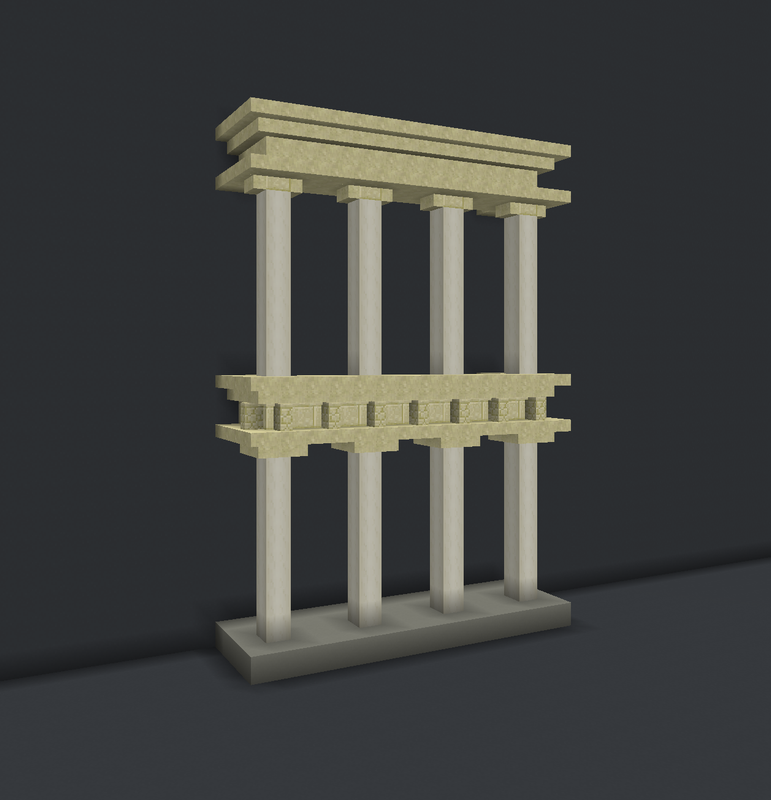
In the previous case of a multi-storey building it almost always advisable to use only standard columns: monumental columns are too large to be used in multiples storeys since they would make the construction look enourmous and not realistic. (However it may be an option if you have to build a skyscraper or something... but we are not talking about antiquity anymore.)
Alternatively it's possible to use different orders with different scales, for example if you have monumental Corinthian columns decorating a building wall you can use Ionic standard columns to decorate doors and entrances down below. In this case Corinthian and Ionic start from the same level but Corinthian is made with another scale (bigger) and so it's somehow still "above" Ionic.

.
| Progress | 100% complete |
| Tags |
tools/tracking
4733295
2
tutorial-4733295

















Create an account or sign in to comment.
I also made in 1x1 the corinthian and composite order. The only thing that is impossible is the lines through the doric column, then when I build the pillar the only thing to make it different from tuscan is the quartz pillar.